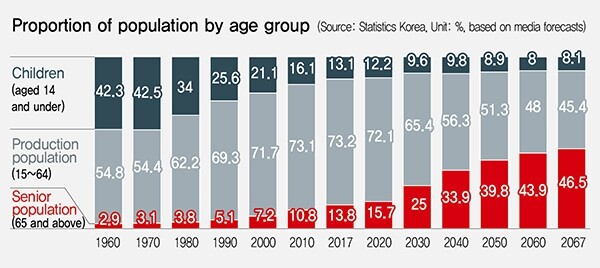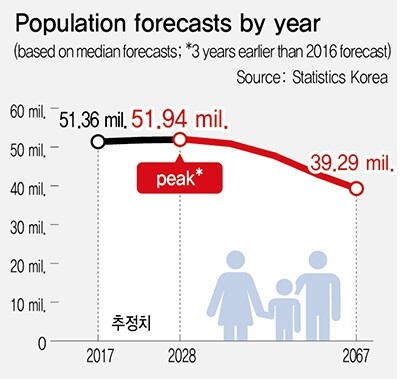hankyoreh
Links to other country sites 다른 나라 사이트 링크
S. Korea’s population decline set to arrive 3 years earlier than previous forecasts

The beginning of a decline in South Korea’s total population is now being predicted to arrive three years ahead of previous forecasts.
Some even gloomier predictions delivered a worst-case scenario where the population decline could start as soon as next year.
On Mar. 28, Statistics Korea published a report titled “Special Estimate of the Future Population (2017–2067),” in which it predicted South Korea’s total population would reach a peak of 51.94 million by 2028 before entering a decline – eventually dropping to its 1982 level of 39.29 million 40 years later in 2067. In a previous “Future Population Estimate” report published in 2016, Statistics Korea predicted the population peak year would come in 2031.

Statistics Korea predicted the future population according to three different scenarios (high, medium, and low) based on variables that could influence the total, including birth rate and life expectancy. The latest prediction of 2028 as the population peak year was based on the medium (standard) estimate. The agency also predicted the peak and beginning of population decline could come as early as this year in the event that the birth rate and other variables reach the “low” estimate level representing a worst-case scenario.
A Statistics Korea official explained, “Since the population estimates were a reflection of the recent situation with a sharp decline in the fertility rate, the likelihood of a worst-case scenario coming to pass is more or less nonexistent.”
“The recent plunge in the birth rate is predicted to continue through around 2022,” the official said.
Also predicted were severe shocks to the economy and society from changes in the demographic structure. Over the 10-year period starting in 2017, Statistics Korea forecast a 2.5 million-person decline in the productive population aged 15–64 and a 4.52 million-person increase in the senior citizen population over 65. As of 2017, the productive population represented 73.2% of the total population, serving as a true “backbone” to the South Korean economy. But that proportion is predicted to drop heavily to 65.4% by 2030 and 45.4% in 2067. Indeed, a reversal is projected between the age groups by 2067, with a productive population of 17.84 million and a senior citizen population of 18.27 million.
Accordingly, the total dependency ratio – which represent the number of dependents (small children and senior citizens) supported by every 100 members of the productive population – was predicted to rise from 36.7 in 2017 to 120.2 by 2067. As of 2017, South Korea had the lowest total dependency ratio among OECD members; by 2065, it is expected to have the highest. The median age, representing the age of the centermost person if the entire population were lined up, is also predicted to rise from 42 in 2017 to 62.2 as of 2067.
By Noh Hyun-woong, staff reporter
Please direct comments or questions to [english@hani.co.kr]

Editorial・opinion
![[Guest essay] The real reason Korea’s new right wants to dub Rhee a founding father [Guest essay] The real reason Korea’s new right wants to dub Rhee a founding father](https://flexible.img.hani.co.kr/flexible/normal/500/300/imgdb/original/2024/0423/8317138574257878.jpg) [Guest essay] The real reason Korea’s new right wants to dub Rhee a founding father
[Guest essay] The real reason Korea’s new right wants to dub Rhee a founding father![[Column] ‘Choson’: Is it time we start referring to N. Korea in its own terms? [Column] ‘Choson’: Is it time we start referring to N. Korea in its own terms?](https://flexible.img.hani.co.kr/flexible/normal/500/300/imgdb/original/2024/0423/3617138579390322.jpg) [Column] ‘Choson’: Is it time we start referring to N. Korea in its own terms?
[Column] ‘Choson’: Is it time we start referring to N. Korea in its own terms?- [Editorial] Japan’s rewriting of history with Korea has gone too far
- [Column] The president’s questionable capacity for dialogue
- [Column] Are chaebol firms just pizza pies for families to divvy up as they please?
- [Column] Has Korea, too, crossed the Rubicon on China?
- [Correspondent’s column] In Japan’s alliance with US, echoes of its past alliances with UK
- [Editorial] Does Yoon think the Korean public is wrong?
- [Editorial] As it bolsters its alliance with US, Japan must be accountable for past
- [Guest essay] Amending the Constitution is Yoon’s key to leaving office in public’s good graces
Most viewed articles
- 1[Column] ‘Choson’: Is it time we start referring to N. Korea in its own terms?
- 2Senior doctors cut hours, prepare to resign as government refuses to scrap medical reform plan
- 3[Guest essay] The real reason Korea’s new right wants to dub Rhee a founding father
- 4Why Korea shouldn’t welcome Japan’s newly beefed up defense cooperation with US
- 5Opposition calls Yoon’s chief of staff appointment a ‘slap in the face’
- 6New AI-based translation tools make their way into everyday life in Korea
- 7Terry Anderson, AP reporter who informed world of massacre in Gwangju, dies at 76
- 8[Column] The clock is ticking for Korea’s first lady
- 9Samsung barricades office as unionized workers strike for better conditions
- 10Korean government’s compromise plan for medical reform swiftly rejected by doctors